Visiting Professor Teaches Molecular Gastronomy Techniques

Purifcación Garcia Segovia, visiting scholar from Universidad Politécnica de Valencia, Spain, right, teaches Quyen Nquyen and Ruben Morawicki, assistant professor of food science, a recipe during a molecular gastronomy workshop in the Bumpers College Culinary Laboratory in the Home Economics Building.
FAYETTEVILLE, Ark. – Area chefs and other students of culinary arts and sciences learned to make melon caviar and other novel dishes using techniques such as spherification at a molecular gastronomy workshop June 8-15 in the Culinary Laboratory kitchen in the Home Economics Building.
Purificación Garcia Segovia, a food science professor from Universidad Politécnica de Valencia in Spain, taught the workshop as a visiting scholar in the hospitality and restaurant management program in Dale Bumpers College of Agricultural, Food and Life Sciences.
Professor Robert Harrington said he will incorporate the techniques in courses such as "Food and Wine" fall semester. Hospitality and restaurant management is a concentration in the food, human nutrition and hospitality major in Bumpers College's School of Human Environmental Sciences. The college also offers a major in food science, whose students and faculty members also participated in the workshop.
Segovia said texturing techniques apply scientific principles and tools to designing new dishes with unique textures.
"Texture manipulation is a key technique in the Modernist kitchen as an enhancement that intensifies the ultimate enjoyment of a presentation," Segovia said.
Spherification is controlled gelification of a liquid containing sodium alginate that forms spheres of different sizes when submerged in a calcium bath. The reaction can be controlled to determine the size of spheres formed.
Segovia said the techniques allow cooks to apply physics and chemistry technology to create new presentations of food. Some specialized equipment is required, which is available in affordable kits designed for home kitchens, she said.
Consumers should not be alarmed by the long names of some ingredients used in molecular gastronomy because they are from natural sources, Segovia said. Sodium alginate is from algae. Others include kappa carrageenan, xanthium gum, tapioca maltodextrin, gelatin and soy lecithin.
As editor in chief of the Journal of Culinary Science and Technology, Harrington added a section on molecular gastronomy, which is broadly defined as the application of science to cooking. A history of the discipline is provided in Molecular Gastronomy in France, by Hervé This, in Vol. 9, No. 3, of the journal.
Molecular gastronomy techniques as practiced by many chefs were pioneered by French physicist Hervé This and British food scientist Nicholas Kurti starting about 1988, Harrington said.
Kurti is famously quoted as saying: "I think it is a sad reflection on our civilization that while we can and do measure the temperature in the atmosphere of Venus we do not know what goes on inside our soufflés."
Topics
Contacts
Howell Medders, Coordinator
AGCS
575-5647,
hmedders@uark.edu
Headlines
Four Students Named Goldwater Scholars; Two Earn Udall Honorable Mentions
Four U of A students have received the prestigious Goldwater Scholarship, an award for top students in mathematics, science, and engineering.
Cross-Campus Collaboration Culminates in New Outdoor Geological Installation
Grand opening event to celebrate the new GeoLab installation at the U of A’s Gearhart Hall courtyard is set for May 3. The installation will be open to the public year-round.
First Students to Use Online Degree to Hone Nursing Leadership, Elevate Patient Care
Hanna Baxendale and Wendi Kimbrell will begin coursework in the Doctor of Nursing Practice-Executive Master of Business Administration program offered by the Eleanor Mann School of Nursing and Walton College.
Join the Office for Sustainability on a Final Cruise to Campus
Cruise to Campus Wednesdays have fostered a gathering space for individuals interested in biking to campus. Drop by the Old Main Lawn from 7:30-10 a.m. Wednesday for coffee, something to eat and conversation.
Fay Jones School Student Ambassador Program Gives Voice to Design Students
The student ambassador program at the Fay Jones School of Architecture and Design is built to connect top design students with their school, its alumni, its future students and others inside and outside the school.




